Garmin 420 User Manual
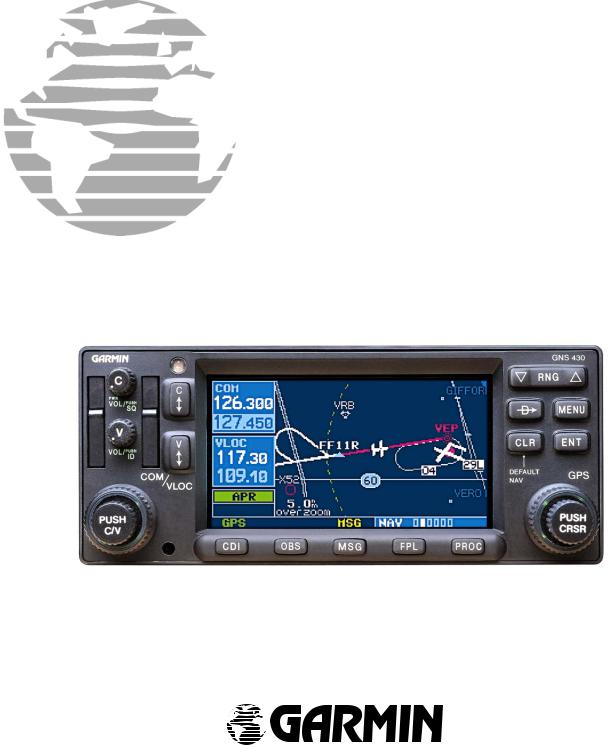
400 SERIES
INSTALLATION MANUAL
GPS 400, GNC TM 420 (A), and GNS TM 430 (A)
GNC and GNS are trademarks of Garmin Ltd. or its subsidiaries and may not be used without the express permission of Garmin.
(GNS 430 Shown)
≤
Garmin International, Inc.
1200 E. 151st Street
Olathe, KS 66062 USA
190-00140-02, Revision L
December 2002

© Copyright 1998 - 2002 Garmin Ltd. or its subsidiaries All Rights Reserved
Except as expressly provided herein, no part of this manual may be reproduced, copied, transmitted, disseminated, downloaded or stored in any storage medium, for any purpose without the express prior written consent of Garmin. Garmin hereby grants permission to download a single copy of this manual and of any revision to this manual onto a hard drive or other electronic storage medium to be viewed and to print one copy of this manual or of any revision hereto, provided that such electronic or printed copy of this manual or revision must contain the complete text of this copyright notice and provided further that any unauthorized commercial distribution of this manual or any revision hereto is strictly prohibited.
Garmin International, Inc.
1200 E. 151st Street
Olathe, KS 66062 USA
Telephone: 913-397-8200
Aviation Panel-Mount Technical Support Line (Toll Free): 1-888-606-5482
Web Site Address: www.garmin.com
RECORD OF REVISIONS
Revision |
Revision |
Description |
ECO # |
Insertion |
By |
|
Date |
|
|
Date |
|
A |
6/19/98 |
Initial Release |
---- |
|
|
|
|
|
|
|
|
B |
10/22/98 |
General update |
9891 |
|
|
C |
11/11/98 |
Add 18 AWG pin positioner and insertion/extraction |
10008 |
|
|
|
|
tools. Add King Serial DME tuning interface |
|
|
|
|
|
description. |
|
|
|
D |
3/18/99 |
Add GNC 420, GPS 400, ARINC 429, GPS King Serial |
10665 |
|
|
|
|
OBI, RS-232 Fuel/Air Data Inputs |
|
|
|
E |
6/25/99 |
Reflect changes to configuration pages, Misc corrections |
11243 |
|
|
|
|
|
|
|
|
F |
10/13/99 |
Add interface to BF Goodrich Stormscope and Skywatch |
11871 |
|
|
|
|
and Ryan TCAD |
|
|
|
G |
4/27/00 |
Update installation accessory kits |
13205 |
|
|
|
|
|
|
|
|
H |
9/1/00 |
Add unit versions with 14/28 volt transmitter. Update |
14026 |
|
|
|
|
configuration pages. |
|
|
|
J |
2/22/01 |
Update configuration pages. |
15207 |
|
|
|
|
|
|
|
|
K |
5/22/02 |
Add gray unit and 16 watt “A” versions. Update |
18149 |
|
|
|
|
configuration pages. |
|
|
|
L |
12/13/02 |
Add Fault Detection and Exclusion |
19779 |
|
|
|
|
|
|
|
|
LIST OF EFFECTIVE PAGES
Page |
Rev. |
Page |
Rev. |
......Page |
Rev. |
Page |
Rev. |
Page |
Rev. |
Page |
Rev. |
Page |
Rev. |
Page |
Rev. |
A ................ |
L |
2-2.............. |
L |
3-19............ |
L |
4-14............ |
L |
4-39 |
........... L |
4-71 |
........... L |
5-16 ........... |
L |
B-8............. |
L |
i.................. |
L |
2-3.............. |
L |
3-21............ |
L |
4-15............ |
L |
4-41 ........... |
L |
5-1 ............. |
L |
5-17 ........... |
L |
C-1............. |
L |
ii................. |
L |
2-4.............. |
L |
3-23............ |
L |
4-16............ |
L |
4-43 ........... |
L |
5-2 ............. |
L |
5-18 ........... |
L |
C-2............. |
L |
iii................ |
L |
3-1.............. |
L |
4-1.............. |
L |
4-17............ |
L |
4-45 ........... |
L |
5-3 ............. |
L |
A-1 ............ |
L |
C-3............. |
L |
iv................ |
L |
3-2.............. |
L |
4-2.............. |
L |
4-18............ |
L |
4-47 ........... |
L |
5-4 ............. |
L |
A-2 ............ |
L |
C-4............. |
L |
v ................. |
L |
3-3.............. |
L |
4-3.............. |
L |
4-19............ |
L |
4-49 ........... |
L |
5-5 ............. |
L |
A-3 ............ |
L |
D-1 ............ |
L |
vi ................ |
L |
3-4.............. |
L |
4-4.............. |
L |
4-20............ |
L |
4-51 ........... |
L |
5-6 ............. |
L |
A-4 ............ |
L |
D-2 ............ |
L |
1-1.............. |
L |
3-5.............. |
L |
4-5.............. |
L |
4-21............ |
L |
4-53 ........... |
L |
5-7 ............. |
L |
A-5 ............ |
L |
D-3 ............ |
L |
1-2.............. |
L |
3-6.............. |
L |
4-6.............. |
L |
4-23............ |
L |
4-55 ........... |
L |
5-8 ............. |
L |
A-6 ............ |
L |
D-4 ............ |
L |
1-3.............. |
L |
3-7.............. |
L |
4-7.............. |
L |
4-25............ |
L |
4-57 ........... |
L |
5-9 ............. |
L |
B-1............. |
L |
E-1............. |
L |
1-4.............. |
L |
3-8.............. |
L |
4-8.............. |
L |
4-27............ |
L |
4-59 ........... |
L |
5-10 ........... |
L |
B-2............. |
L |
E-2............. |
L |
1-5.............. |
L |
3-9.............. |
L |
4-9.............. |
L |
4-29............ |
L |
4-61 ........... |
L |
5-11 ........... |
L |
B-3............. |
L |
|
|
1-6.............. |
L |
3-11............ |
L |
4-10............ |
L |
4-31............ |
L |
4-63 ........... |
L |
5-12 ........... |
L |
B-4............. |
L |
|
|
1-7.............. |
L |
3-13............ |
L |
4-11............ |
L |
4-33............ |
L |
4-65 ........... |
L |
5-13 ........... |
L |
B-5............. |
L |
|
|
1-8 |
L |
3-15............ |
L |
4-12............ |
L |
4-35............ |
L |
4-67 ........... |
L |
5-14 ........... |
L |
B-6............. |
L |
|
|
2-1.............. |
L |
3-17............ |
L |
4-13............ |
L |
4-37............ |
L |
4-69 ........... |
L |
5-15 ........... |
L |
B-7............. |
L |
|
|
Page A |
400 SERIES INSTALLATION MANUAL |
Page Rev L |
P/N 190-00140-02 |

This manual is written for software version 3.00, and is not suitable for earlier software versions. Information in this document is subject to change without notice. Visit the Garmin web site (www.garmin.com) for current updates and supplemental information concerning the operation of this and other Garmin products.
INFORMATION SUBJECT TO EXPORT CONTROL LAWS
This document may contain information which is subject to the Export Administration Regulations ("EAR") issued by the United States Department of Commerce (15 CFR, Chapter VII, Subchapter C) and which may not be exported, released, or disclosed to foreign nationals inside or outside of the United States without first obtaining an export license. A violation of the EAR may be subject to a penalty of up to 10 years imprisonment and a fine of up to $1,000,000 under Section 2410 of the Export Administration Act of 1979. Include this notice with any reproduced portion of this document.
WARNING
This product, its packaging, and its components contain chemicals known to the State of California to cause cancer, birth defects, or reproductive harm. This Notice is being provided in accordance with California's Proposition 65. If you have any questions or would like additional information, please refer to our web site at www.garmin.com/prop65.
400 SERIES INSTALLATION MANUAL |
Page i |
P/N 190-00140-02 |
Page Rev L |

TABLE OF CONTENTS
1. GENERAL DESCRIPTION |
|
1.1 INTRODUCTION ......................................................................................................................................... |
1-1 |
1.2 EQUIPMENT DESCRIPTION...................................................................................................................... |
1-1 |
1.3 TECHNICAL SPECIFICATIONS................................................................................................................. |
1-2 |
1.4 LICENSE REQUIREMENTS ....................................................................................................................... |
1-7 |
1.5 CERTIFICATION ......................................................................................................................................... |
1-7 |
1.6 FAULT DETECTION AND EXCLUSION (FDE) ...................................................................................... |
1-7 |
1.7 LIMITED WARRANTY ............................................................................................................................... |
1-8 |
2. INSTALLATION |
|
2.1 INTRODUCTION ......................................................................................................................................... |
2-1 |
2.2 ANTENNA CONSIDERATIONS ................................................................................................................. |
2-1 |
2.3 RACK CONSIDERATIONS ......................................................................................................................... |
2-3 |
2.4 CABLING AND WIRING ............................................................................................................................ |
2-3 |
2.5 COOLING AIR.............................................................................................................................................. |
2-3 |
2.6 MINIMUM INSTALLATION REQUIREMENTS ....................................................................................... |
2-3 |
3. INSTALLATION PROCEDURE |
|
3.1 UNIT AND ACCESSORIES......................................................................................................................... |
3-1 |
3.2 DATA BASE OPTIONS................................................................................................................................ |
3-4 |
3.3 MISCELLANEOUS OPTIONS..................................................................................................................... |
3-4 |
3.4 INSTALLATION ACCESSORIES REQUIRED BUT NOT PROVIDED ................................................... |
3-4 |
3.5 ANTENNA INSTALLATION ...................................................................................................................... |
3-4 |
3.6 CABLE INSTALLATION............................................................................................................................. |
3-5 |
3.7 RACK INSTALLATION............................................................................................................................... |
3-6 |
3.8 400 SERIES UNIT INSERTION AND REMOVAL..................................................................................... |
3-7 |
3.9 COM ANTENNA INSTALLATION CHECK (GNC 420 AND GNS 430).................................................. |
3-7 |
3.10 GA 56 ANTENNA INSTALLATION DRAWING..................................................................................... |
3-9 |
3.11 MOUNTING RACK DIMENSIONS........................................................................................................... |
3-11 |
3.12 MOUNTING RACK INSTALLATION ...................................................................................................... |
3-17 |
3.13 RECOMMENDED PANEL CUTOUT DIMENSIONS .............................................................................. |
3-23 |
4. SYSTEM INTERCONNECTS |
|
4.1 PIN FUNCTION LIST................................................................................................................................... |
4-1 |
4.2 POWER, LIGHTING, AND ANTENNAS.................................................................................................... |
4-5 |
4.3 ALTIMETER................................................................................................................................................. |
4-6 |
4.4 MAIN INDICATOR ...................................................................................................................................... |
4-7 |
4.5 ANNUNCIATORS/SWITCHES ................................................................................................................... |
4-9 |
4.6 SERIAL DATA ............................................................................................................................................. |
4-11 |
4.7 COM/VOR/ILS AUDIO (GNC 420 AND GNS 430 ONLY) ........................................................................ |
4-14 |
4.8 VOR/ILS INDICATOR (GNS 430 ONLY)................................................................................................... |
4-16 |
4.9 RMI/OBI........................................................................................................................................................ |
4-18 |
4.10 DME TUNING (GNS 430 ONLY) .............................................................................................................. |
4-19 |
4.11 400 SERIES INTERCONNECTS................................................................................................................ |
4-21 |
5. POST INSTALLATION CONFIGURATION & CHECKOUT PROCEDURE |
|
5.1 CONFIGURATION MODE OPERATIONS................................................................................................. |
5-1 |
5.2 INSTALLATION CONFIGURATION PAGES............................................................................................ |
5-1 |
5.3 ADDITIONAL GROUND TESTS ................................................................................................................ |
5-16 |
Appendix A. CERTIFICATION DOCUMENTS |
|
A.1 CONTINUED AIRWORTHINESS .............................................................................................................. |
A-1 |
A.2 ENVIRONMENTAL QUALIFICATION FORM—GNS 430...................................................................... |
A-3 |
A.3 ENVIRONMENTAL QUALIFICATION FORM—GNC 420 ..................................................................... |
A-4 |
A.4 ENVIRONMENTAL QUALIFICATION FORM—GPS 400 ...................................................................... |
A-5 |
A.5 ENVIRONMENTAL QUALIFICATION FORM—GA 56.......................................................................... |
A-6 |
Appendix B. STC PERMISSION ................................................................................................................................ |
B-1 |
Appendix C. 400 SERIES RS-232 AVIATION DATA FORMAT ............................................................................. |
C-1 |
Appendix D. 400 SERIES RS-232 FUEL/AIR DATA INPUT FORMAT.................................................................. |
D-1 |
Appendix E. 400 SERIES LRU INTERFACE OVERVIEW ...................................................................................... |
E-1 |
Note: Throughout this document references made to GNS 430 and GNC 420 shall equally apply to the GNS 430A and GNC 420A except where specifically noted.
Page ii |
400 SERIES INSTALLATION MANUAL |
Page Rev L |
P/N 190-00140-02 |

LIST OF FIGURES
FIGURE 2-1. GPS ANTENNA AND UNIT INSTALLATION CONSIDERATIONS ............................................. |
2-2 |
FIGURE 3-1. COAXIAL CABLE INSTALLATION ................................................................................................ |
3-5 |
FIGURE 3-2. GA 56 ANTENNA INSTALLATION DRAWING ............................................................................. |
3-9 |
FIGURE 3-3. GNS 430 MOUNTING RACK DIMENSIONS ................................................................................... |
3-11 |
FIGURE 3-4. GNC 420 MOUNTING RACK DIMENSIONS................................................................................... |
3-13 |
FIGURE 3-5. GPS 400 MOUNTING RACK DIMENSIONS.................................................................................... |
3-15 |
FIGURE 3-6. GNS 430 MOUNTING RACK INSTALLATION............................................................................... |
3-17 |
FIGURE 3-7. GNC 420 MOUNTING RACK INSTALLATION .............................................................................. |
3-19 |
FIGURE 3-8. GPS 400 MOUNTING RACK INSTALLATION ............................................................................... |
3-21 |
FIGURE 3-9. 400 SERIES RECOMMENDED PANEL CUTOUT DIMENSIONS.................................................. |
3-23 |
FIGURE 4-1. 400 SERIES SYSTEM INTERFACE DIAGRAM .............................................................................. |
4-21 |
FIGURE 4-2. GNS 430 TYPICAL INSTALLATION ............................................................................................... |
4-23 |
FIGURE 4-3. GNC 420 TYPICAL INSTALLATION............................................................................................... |
4-25 |
FIGURE 4-4. GPS 400 TYPICAL INSTALLATION ................................................................................................ |
4-27 |
FIGURE 4-5. POWER, LIGHTING, AND ANTENNAS INTERCONNECT........................................................... |
4-29 |
FIGURE 4-6. ALTIMETER INTERCONNECT........................................................................................................ |
4-31 |
FIGURE 4-7. MAIN INDICATOR INTERCONNECT ............................................................................................. |
4-33 |
FIGURE 4-8. KI 209A MAIN INDICATOR INTERCONNECT .............................................................................. |
4-35 |
FIGURE 4-9. KI 208A MAIN INDICATOR INTERCONNECT .............................................................................. |
4-37 |
FIGURE 4-10. ANNUNCIATORS/SWITCHES INTERCONNECT ........................................................................ |
4-39 |
FIGURE 4-11. RS-232 SERIAL DATA INTERCONNECT ..................................................................................... |
4-41 |
FIGURE 4-12. ARINC 429 EFIS INTERCONNECT ................................................................................................ |
4-43 |
FIGURE 4-13. ARINC 429 SANDEL EHSI INTERCONN. (1 400 SERIES UNIT, 1 SANDEL SN3308).............. |
4-45 |
FIGURE 4-14. ARINC 429 SANDEL EHSI INTERCONNECT (2 GNS 430, 1 SANDEL SN3308)....................... |
4-47 |
FIGURE 4-15. ARINC 429 SANDEL EHSI INTERCONNECT (2 GNS 430, 2 SANDEL SN3308)....................... |
4-49 |
FIGURE 4-16. ARINC 429 AIR DATA/IRU/AHRS INTERCONNECT.................................................................. |
4-51 |
FIGURE 4-17. ARINC 429 FLIGHT CONTROL INTERCONNECT ...................................................................... |
4-53 |
FIGURE 4-18. TRAFFIC ADVISORY SYSTEM INTERCONNECT ...................................................................... |
4-55 |
FIGURE 4-19. WEATHER AND TERRAIN INTERCONNECT ............................................................................. |
4-57 |
FIGURE 4-20. AUDIO PANEL INTERCONNECT.................................................................................................. |
4-59 |
FIGURE 4-21. VOR/ILS INDICATOR INTERCONNECT ...................................................................................... |
4-61 |
FIGURE 4-22. RMI/OBI INTERCONNECT ............................................................................................................. |
4-63 |
FIGURE 4-23. KING SERIAL PANEL DME TUNING INTERCONNECT ............................................................ |
4-65 |
FIGURE 4-24. KING SERIAL REMOTE DME TUNING INTERCONNECT......................................................... |
4-67 |
FIGURE 4-25. PARALLEL 2 OF 5 DME TUNING INTERCONNECT .................................................................. |
4-69 |
FIGURE 4-26. PARALLEL BCD/SLIP CODE DME TUNING INTERCONNECT ................................................ |
4-71 |
Note: Throughout this document references made to GNS 430 and GNC 420 shall equally apply to the GNS 430A and GNC 420A except where specifically noted.
400 SERIES INSTALLATION MANUAL |
Page iii |
P/N 190-00140-02 |
Page Rev L |

LIST OF FIGURES - CONTINUED
FIGURE 5-1. MAIN ARINC 429 CONFIG PAGE.................................................................................................... |
5-1 |
FIGURE 5-2. MAIN RS232 CONFIG PAGE ............................................................................................................ |
5-3 |
FIGURE 5-3. MAIN INPUTS 1 PAGE ...................................................................................................................... |
5-4 |
FIGURE 5-4. MAIN INPUTS 2 PAGE ...................................................................................................................... |
5-4 |
FIGURE 5-5. INSTRUMENT PANEL SELF TEST PAGE ...................................................................................... |
5-5 |
FIGURE 5-6. MAIN LIGHTING PAGE.................................................................................................................... |
5-5 |
FIGURE 5-7. MAIN LIGHTING PAGE (DISPLAY LIGHTING FROM LIGHTING BUS) ................................... |
5-6 |
FIGURE 5-8. DISPLAY PAGE (AUX GROUP) ....................................................................................................... |
5-6 |
FIGURE 5-9. DATE/TIME SETUP PAGE................................................................................................................ |
5-6 |
FIGURE 5-10. MAIN DISCRETE INPUTS PAGE ................................................................................................... |
5-6 |
FIGURE 5-11. MAIN DISCRETE OUTPUTS PAGE ............................................................................................... |
5-7 |
FIGURE 5-12. MAIN CDI/OBS CONFIG PAGE...................................................................................................... |
5-7 |
FIGURE 5-13. COM SETUP PAGE (GNC 420 AND GNS 430 ONLY) .................................................................. |
5-9 |
FIGURE 5-14. VOR DISCRETE INPUTS PAGE (GNS 430 ONLY)....................................................................... |
5-10 |
FIGURE 5-15. VOR/LOC/GS CDI PAGE (GNS 430 ONLY)................................................................................... |
5-10 |
FIGURE 5-16. VOR/LOC/GS ARINC 429 CONFIG PAGE (GNS 430 ONLY)....................................................... |
5-11 |
FIGURE 5-17. STORMSCOPE CONFIG PAGE....................................................................................................... |
5-12 |
FIGURE 5-18. STORMSCOPE TEST PAGE ............................................................................................................ |
5-12 |
FIGURE 5-19. STORMSCOPE DOWNLOAD DATA PAGE .................................................................................. |
5-12 |
FIGURE 5-20. TRAFFIC PAGE (SKYWATCH) ...................................................................................................... |
5-13 |
FIGURE 5-21. TRAFFIC PAGE (TCAD).................................................................................................................. |
5-13 |
FIGURE 5-22. RYAN TCAD CONFIG PAGE.......................................................................................................... |
5-13 |
FIGURE 5-23. GAD 42 CONFIG PAGE ................................................................................................................... |
5-13 |
FIGURE 5-24. DATA LINK PAGE........................................................................................................................... |
5-14 |
Note: Throughout this document references made to GNS 430 and GNC 420 shall equally apply to the GNS 430A and GNC 420A except where specifically noted.
Page iv |
400 SERIES INSTALLATION MANUAL |
Page Rev L |
P/N 190-00140-02 |

400 SERIES HARDWARE MOD LEVEL HISTORY
The following table identifies hardware modification (Mod) Levels for the GPS 400, GNC 420 and GNS 430. Mod Levels are listed with the associated service bulletin number, service bulletin date, and the purpose of the modification. The table is current at the time of publication of this manual (see date on front cover) and is subject to change without notice. Authorized Garmin Sales and Service Centers are encouraged to access the most up-to-date bulletin and advisory information on the Garmin Dealer Resource web site at www.garmin.com using their Garmin -provided user name and password.
MOD |
SERVICE |
SERVICE |
PURPOSE OF MODIFICATION |
LEVEL |
BULLETIN |
BULLETIN |
|
|
NUMBER |
DATE |
|
|
|
|
|
1 |
9905 |
9/17/99 |
CDI/HSI deviation error; GNS 430, P/N 011- |
|
|
|
00280-00, GNC 420, P/N 011-00506-00, GPS |
|
|
|
400, P/N 011-00504-00 |
|
|
|
|
1 |
0019 |
11/07/00 |
Replace fuse in COM circuit with a resistor; |
|
|
|
GNS 430, P/N 011-00280-10, GNC 420, P/N |
|
|
|
011-00506-10, GNS 530, P/N 011-00550-10 |
|
|
|
|
2 |
0101 |
2/16/01 |
Remote COM transfer |
|
|
|
|
3 |
0203, Rv B |
8/12/02 |
Improve receiver audio compressor |
|
|
|
performance |
|
|
|
|
4 |
0207 |
4/2/02 |
Remove excess solder from COM board |
|
|
|
|
5 |
0211 |
6/4/02 |
Reduce input transients from Audio Panel |
|
|
|
|
|
|
|
|
|
|
|
|
Note: Throughout this document references made to GNS 430 and GNC 420 shall equally apply to the GNS 430A and GNC 420A except where specifically noted.
400 SERIES INSTALLATION MANUAL |
Page v |
P/N 190-00140-02 |
Page Rev L |

This page intentionally left blank
Page vi |
400 SERIES INSTALLATION MANUAL |
Page Rev L |
P/N 190-00140-02 |

1.GENERAL DESCRIPTION
1.1INTRODUCTION
This manual describes the physical, mechanical, and electrical characteristics and the installation requirements for the 400 Series (GPS 400, GNC 420, and GNS 430) Panel-mounted units. After installation of the 400 Series system, FAA Form 337 must be completed by an appropriately certificated agency to return the aircraft to service.
1.2EQUIPMENT DESCRIPTION
The 400 Series units are mark width (6.25” wide) units, and 2.66” high. The display is a 128 by 240 pixel color LCD. The units include two removable data cards, one with a Jeppesen database, and the second being an optional custom data card.
The GPS 400 is a GPS receiver certifiable for IFR en route, terminal, and non-precision approach operations.
The GNC 420/ (A) includes all the features of the GPS 400, and also includes an IFR certified airborne VHF communications transceiver. The (A) model is a 28 Vdc unit with a 16 Watt COM transmitter.
The GNS 430/ (A) includes all the features of the GNC 420, and also includes IFR certified airborne VOR/Localizer and Glideslope receivers. The (A) model is a 28 Vdc unit with a 16 Watt COM transmitter.
GPS signals are received by Garmin's low profile GA 56 antenna (P/N 010-10040-0X).
CAUTION
The 400 Series product lens is coated with a special anti-reflective coating which is very sensitive to skin oils, waxes and abrasive cleaners. It is very important to clean the lens using an eyeglass lens cleaner which is specified as safe for anti-reflective coatings (one suitable product is Wal-Mart® Lens Cleaner) and a clean, lint-free cloth.
CAUTION
The use of cellular telephones while aircraft are airborne is prohibited by FCC rules. Due to potential interference with onboard systems, the use of cell phones while the aircraft is on the ground is subject to FAA regulations (Part 91.21).
FCC regulation 47 CFR Ch.1 (Section 22.925) prohibits airborne operation of cellular telephones installed in or carried aboard aircraft. Cellular telephones must not be operated while aircraft are off the ground. When any aircraft leaves the ground, all cellular telephones on board that aircraft must be turned off.
Cell phones that are on, even in a monitoring state, can disrupt GPS performance.
400 SERIES INSTALLATION MANUAL |
Page 1-1 |
P/N 190-00140-02 |
Page Rev L |

1.3TECHNICAL SPECIFICATIONS
The conditions and tests required for TSO approval of the 400 Series are minimum performance standards. It is the responsibility of those desiring to install this article either on or within a specific type or class of aircraft to determine that the aircraft installation conditions are within the TSO standards. The article may be installed only if further evaluation by the applicant documents an acceptable installation and is approved by the administrator. For TSO Compliance, see Appendix A.
1.3.1 Physical Characteristics
Bezel Height |
2.66 in. (67 mm) |
Bezel Width |
6.25 in. (159 mm) |
Rack Height (Dimple-to- |
2.69 in. (68 mm) |
dimple) |
|
Rack Width |
6.32 in. (160 mm) |
Depth Behind Panel with |
11.00 in. (279 mm) |
Connectors (Measured from |
|
face of aircraft panel to rear of |
|
connector backshells) |
|
GPS 400 Weight (Unit only) |
3.8 lbs. (1.7 kg) |
GPS 400 Weight (Installed with |
4.9 lbs. (2.2 kg) |
rack and connectors) |
|
GNC 420 Weight (Unit only) |
4.5 lbs. (2.0 kg) |
GNC 420 Weight (Installed with |
5.8 lbs. (2.6 kg) |
rack and connectors) |
|
GNS 430 Weight (Unit only) |
5.1 lbs. (2.3 kg) |
GNS 430 Weight (Installed with |
6.5 lbs. (2.9 kg) |
rack and connectors) |
|
Page 1-2 |
400 SERIES INSTALLATION MANUAL |
Page Rev L |
P/N 190-00140-02 |

1.3.2 General Specifications |
|
Operating Temperature Range |
-20°C to +55°C. For more details see Environmental |
|
Qualification Form. |
Humidity |
95% non-condensing |
Altitude Range |
-1,500 ft to 50,000 ft |
Input Voltage Range (GPS 400) |
11 to 33 VDC |
Input Voltage Range |
22 to 33 VDC |
GNS 430 (011-00280-00) and |
|
GNC 420 (011-00506-00) |
|
Input Voltage Range |
11 to 33 VDC |
GNS 430 (011-00280-10, -30) |
|
GNC 420 (011-00506-10, -30) |
|
GNS 430 (A) (011-00836-00,-10) |
28 VDC |
GNC 420 (A) (011-00837-00,-10) |
|
Power Requirements—P4001 |
0.72 A @ 27.5 VDC________or |
(GPS 400 Main Connector) |
1.44 A @ 13.75 VDC |
Power Requirements—P4001 |
1.5 A @ 27.5 VDC (maximum) |
(GNC 420 Main Connector) |
|
Power Requirements—P4001 |
1.5 A @ 27.5 VDC (maximum) |
(GNS 430 Main Connector) |
|
Power Requirements—P4002 |
15 mA @ 27.5 VDC (not transmitting); |
(COM Connector) |
3.0 A @ 27.5 VDC (transmitting) |
GNS 430 (011-00280-00) |
|
GNS 430A (011-00836-00, -10) |
|
and |
|
GNC 420 (011-00506-00) |
|
GNC 420A (011-00837-00, -10) |
|
Power Requirements—P4002 |
15 mA @ 27.5 VDC (not transmitting); |
(COM Connector) |
3.0 A @ 27.5 VDC (transmitting)_______or |
GNS 430 (011-00280-10, -30) |
10 mA @ 13.75 VDC (not transmitting); |
and GNC 420 (011-00506-10) |
6.0 A @ 13.75 VDC (transmitting) |
Superflag Power Requirements |
500 mA max. per superflag output @ 27.5 VDC. |
|
1.0 A max. @ 27.5 VDC on P4001 (Main Superflags). |
|
1.0 A max. @ 27.5 VDC on P4006 (VOR/LOC, G/S |
|
Superflags). |
Software |
RTCA DO-178B level C |
Environmental Testing |
RTCA DO-160C. |
|
For more details see Environmental Qualification Forms. |
1.3.3 GPS Specifications
Regulatory Compliance |
TSO C129a, RTCA DO-208 |
Acquisition Time |
a) Search-the-Sky (without almanac, without initial position |
|
or time): 5 minutes |
|
b) AutoLocate™ (with almanac, without initial position or |
|
time): 5 minutes |
|
c) Cold Start (position known to 300 nm, time known to 10 |
|
minutes, with valid almanac): 45 seconds |
|
d) Warm Start (position known to 10 nm, time known to 10 |
|
minutes, with valid almanac and ephemeris): 15 seconds |
Max Velocity |
1000 kts. |
Dynamics |
6 g |
400 SERIES INSTALLATION MANUAL |
Page 1-3 |
P/N 190-00140-02 |
Page Rev L |

1.3.4COM Transceiver Specifications (GNC 420 and GNS 430 Only) **
Regulatory Compliance |
TSO-C37d Class 4 & 6* (3 & 5 for “A” models), TSO-C38d |
|
Class C & E, JTSO-2C37e, JTSO-2C38e, RTCA DO-186a |
|
ICAO Annex 10 Volume III (Part II – Voice Communications |
|
Systems) Par. 2.3.3 |
Audio Output |
100 mW minimum into a 500 Ω load. |
Audio Response |
Less than 6 dB of variation between 350 and 2500 Hz. |
Audio Distortion |
The distortion in the receiver audio output shall not exceed |
|
15% at all levels up to 100 mW. |
AGC Characteristics |
The audio output shall not vary by more than 6 dB when the |
|
level of the RF input signal, modulated 30% at 1000 Hz, is |
|
varied from 5 µV to 450,000 µV. |
Sensitivity |
(S+N)/N on all channels shall be greater than 6 dB when the |
|
RF level is 2 µV (hard) modulated 30% at 1000 Hz at rated |
|
audio. |
Squelch |
2 µv ±6 dB for 25 kHz channels. |
|
3 µv ±6 dB for 8.33 kHz channels. |
Selectivity |
6 dB BW is greater than ±8 kHz for 25 kHz channeling. |
|
60 dB BW is less than ±25 kHz for 25 kHz channeling. |
|
6 dB BW is greater than ±2.778 kHz for 8.33 kHz channeling. |
|
60 dB BW is less than ±7.37 kHz for 8.33 kHz channeling. |
Spurious Response |
Greater than 85 dB. |
Transmitter Power |
At Least 10 watts, 16 watts for “A” models |
Transmitter Duty Cycle |
Recommended 10% maximum. |
Modulation Capability |
The modulation shall not be less than 70% and not greater |
|
than 98% with a standard modulator signal applied to the |
|
transmitter. |
Carrier Noise Level |
Shall be at least 45 dB (S+N)/N. |
Frequency Stability |
0.0005% |
Demodulated Audio Distortion |
Less than 10% distortion when the transmitter is modulated |
|
at least 70%. |
Sidetone |
1.4 VRMS into a 500 Ω load when the transmitter is modulated |
|
at least 70%. |
Demodulated Audio Response |
Shall be less than 6 dB when the audio input frequency is |
|
varied from 350 to 2500 Hz. |
*C37d Class 4 & 6 may not provide suitable COM transmit range for some high-altitude aircraft.
**Specifications shown apply at nominal input voltages of 13.75 Vdc or 27.5 Vdc, as applicable, and with a nominal 50 ohm resistive load at the antenna connector.
Page 1-4 |
400 SERIES INSTALLATION MANUAL |
Page Rev L |
P/N 190-00140-02 |

1.3.5VOR Specifications (GNS 430 Only)
Regulatory Compliance |
TSO C40c, JTSO-2C40c, RTCA DO-196, EuroCAE ED-22B |
|
Receiver Audio Sensitivity |
At -103.5 dBm (S+N)/N shall not be less than 6 dB. |
|
Course Deviation Sensitivity |
-103.5 dBm or less for 60% of standard deflection. |
|
Flag |
The VOR Course Deviation Flag must be flagged: |
|
|
a) in the absence of an RF signal. |
|
|
b) in the absence of the 9960 Hz modulation. |
|
|
c) in the absence of either one of the two 30 Hz |
|
|
modulations. |
|
|
d) When the level of a standard VOR deviation test signal |
|
|
produces less than a 50% of standard deflection. |
|
AGC Characteristics |
From -99 dBm to -13 dBm input of a Standard VOR Audio |
|
|
Test Signal, audio output levels shall not vary more than 3 |
|
|
dB. |
|
Spurious Response |
Greater than 80 dB. |
|
VOR OBS Bearing Accuracy |
The bearing information as presented to the pilot shall not |
|
|
have an error in excess of 2.7° as specified by RTCA DO-196 |
|
|
and EuroCAE ED-22B. |
|
Audio Output |
A minimum 100 mW into a 500 Ω load. |
|
Audio Response |
Less than 6 dB of variation between 350 and 2500 Hz. |
|
|
Except the 1020 Hz Ident Tone is at least 20 dB down in |
|
|
voice mode. |
|
Audio Distortion |
The distortion in the receiver audio output shall not exceed |
|
|
10% at all levels up to 100 mW. |
|
400 SERIES INSTALLATION MANUAL |
Page 1-5 |
P/N 190-00140-02 |
Page Rev L |

1.3.6LOC Specifications (GNS 430 Only)
Regulatory Compliance |
TSO C36e, JTSO-C36e, RTCA DO-195 CLASS A, EuroCAE |
|
|
ED-46B |
|
Receiver Audio Sensitivity |
At -103.5 dBm (S+N)/N shall not be less than 6 dB. |
|
Course Deviation Sensitivity |
-103.5 dBm or less for 60% of standard deflection. |
|
Flag |
The LOC Course Deviation Flag must be flagged: |
|
|
a) in the absence of an RF signal. |
|
|
b) When either the 90 or 150 Hz modulating signals is |
|
|
removed and the other is maintained at its normal 20%. |
|
|
c) In the absence of both 90 and 150 Hz modulation. |
|
|
d) When the level of a standard localizer deviation test |
|
|
signal produces less than a 50% of standard deflection. |
|
AGC Characteristics |
From -86 dBm and -33 dBm input of a Standard VOR Audio |
|
|
Test Signal, audio output levels shall not vary more than 3 |
|
|
dB. |
|
Selectivity |
Nose Bandwidth: The input signal level required to produce |
|
|
the reference AGC voltage shall not vary more than 6 dB |
|
|
over the input signal frequency range of ± 9 kHz from the |
|
|
assigned channel frequency. |
|
|
Skirt Bandwidth: The input signal level required to produce |
|
|
reference AGC voltage shall be at least 70 dB greater than |
|
|
the level required to produce reference AGC voltage at the |
|
|
assigned channel frequency at ± 36 kHz from the assigned |
|
|
channel frequency. |
|
Spurious Response |
Greater than 80 dB. |
|
Centering Accuracy |
Typical 0 ± 3 mV (Max error 9.9 mV per RTCA DO-195). |
|
Audio Output |
A minimum 100 mW into a 500 Ω load. |
|
Audio Response |
Less than 6 dB of Variation between 350 and 2500 Hz. |
|
|
Except the 1020 Hz Ident Tone is at least 20 dB down in |
|
|
voice mode. |
|
Audio Distortion |
The distortion in the receiver audio output shall not exceed |
|
|
10% at all levels up to 100 mW. |
|
1.3.7 Glideslope Specifications (GNS 430 Only) |
||
|
|
|
Regulatory Compliance |
TSO C34e, JTSO-C34e, RTCA DO-192, EuroCAE ED-47B |
|
Sensitivity |
-87 dBm or less for 60% of standard deflection. |
|
Centering Accuracy |
0 ± .0091 ddm or 0 ± 7.8 mV |
|
Selectivity |
The course deviation shall be 0 ddm ± .0091ddm when using |
|
|
the Glideslope Centering Test Signal as the RF frequency is |
|
|
varied ±17 kHz from the assigned channel. |
|
|
At frequencies displaced by ±132 kHz or greater, the input |
|
|
signal shall be at least 60 dB down. |
|
Standard deflection |
a) With a standard deflection ‘FLY DOWN’ condition (90 Hz |
|
|
dominant), the output shall be -78 mV ± 7.8 mV. |
|
|
b) With a standard deflection ‘FLY UP’ condition (150 Hz |
|
|
dominant), the output shall be +78 mV ± 7.8 mV. |
|
Flag |
The unit Flags: |
|
|
a) When the level of a standard deviation test signal |
|
|
produces 50% or less of standard deflection of the deviation |
|
|
indicator. |
|
|
b) In the absence of 150 Hz modulation. |
|
|
c) In the absence of 90 Hz modulation. |
|
|
d) In the absence of both 90 Hz and 150 Hz modulation. |
|
|
e) In the absence of RF. |
|
|
|
|
Page 1-6 |
400 SERIES INSTALLATION MANUAL |
|
Page Rev L |
P/N 190-00140-02 |
|

1.4LICENSE REQUIREMENTS
The following guidance is provided to help ensure the proper licensing of the GNC 420/GNS 430 COM:
1.The Telecommunications Act of 1996 effective February 8, 1996 provides the FCC discretion to eliminate radio station license requirements for aircraft. At present, an individual license to operate the 400 Series aboard a private aircraft is not needed in many circumstances. Please see FCC Fact Sheet PR5000 or contact the FCC at 1-800-322-1117 for more information.
2.No license change is required for an aircraft which already has a station license per FCC 404 Instructions dated 1994.
3.If an aircraft license is required or desired, contact the FCC at 1-800-322-1117 to request FCC Form 404, “Application for Aircraft Radio Station License,” to apply for FCC authorization. The FCC also has a “Fax on Demand” service to provide forms by FAX at 202-418-0177.
This equipment has been type accepted by the FCC. The bandwidth/emission designator is 6K00 A3E.
CAUTION
THE VHF TRANSMITTER IN THIS EQUIPMENT IS GUARANTEED TO MEET FEDERAL COMMUNICATIONS COMMISSION ACCEPTANCE OVER THE OPERATING TEMPERATURE RANGE. MODIFICATIONS NOT EXPRESSLY APPROVED BY GARMIN COULD INVALIDATE THE LICENSE AND MAKE IT UNLAWFUL TO OPERATE THE EQUIPMENT.
1.5CERTIFICATION
The GPS receivers in the 400 Series units are certified for IFR enroute, terminal, and non-precision approaches. The 400 Series initial certification was accomplished via STC’s by Garmin in a Piper PA32. See Appendix B for copies of the STC’s.
The 400 Series units have been qualified to RTCA/DO-160 Section 22 lightning requirements. Special installation considerations are required, refer to the Environmental Qualification Forms in Appendix A.
1.6FAULT DETECTION AND EXCLUSION (FDE)
NOTE
The 400 Series equipment as installed has been found to comply with the requirements for GPS primary means of navigation in oceanic and remote airspace, when used in conjunction with the 400 Series Trainer Program incorporating the FDE Prediction Program. This does not constitute an operational approval.
The Garmin 400 Series Main and GPS Software version 3.00 and higher incorporate Fault Detection and Exclusion (FDE) display interface and control, satisfying the requirements for GPS as a Primary Means of Navigation for Oceanic/Remote Operations per FAA Notice N8110.60.
Fault Detection and Exclusion consists of two parts. The fault detection function detects a satellite failure that can affect navigation. The exclusion function refers to the capability of excluding one or more failed satellites and preventing them from affecting navigation.
FDE is provided for Oceanic and Remote Operations, non-precision approaches, en route and terminal phases of flight. FDE for non-oceanic flight phases adhere to the same missed alert probability, false alert probability, and failed exclusion probability specified by N8110.60.
400 SERIES INSTALLATION MANUAL |
Page 1-7 |
P/N 190-00140-02 |
Page Rev L |

The FDE function is built into the GPS 400/GNC 420/GNS 430 and does not require pilot interaction. In contrast, the FDE Prediction Program does require pilot interaction and must be used prior to oceanic/remote area flights to predict FDE availability.
The 400 Series Trainer software (Garmin Part Number 190-00176-00) includes an FDE Prediction Program to meet the requirements for GPS as a primary means of navigation for oceanic/remote operations per N8110.60. The oceanic flight phase occurs on the GPS 400/GNC 420/GNS 430 when more than 200 nautical miles from the nearest airport.
All operators using the GPS 400/GNC 420/GNS 430 as primary means of navigation in oceanic/remote areas under FAR parts 91, 121, 125 and 135 must utilize the FDE Prediction Program prior to conducting a flight in these areas.
1.7LIMITED WARRANTY
This Garmin product is warranted to be free from defects in materials or workmanship for one year from the date of purchase. Within this period, Garmin will at its sole option, repair or replace any components that fail in normal use. Such repairs or replacement will be made at no charge to the customer for parts or labor, provided that the customer shall be responsible for any transportation cost. This warranty does not cover failures due to abuse, misuse, accident or unauthorized alteration or repairs.
THE WARRANTIES AND REMEDIES CONTAINED HEREIN ARE EXCLUSIVE AND IN LIEU OF ALL OTHER WARRANTIES EXPRESS OR IMPLIED OR STATUTORY, INCLUDING ANY LIABILITY ARISING UNDER ANY WARRANTY OF MERCHANTABILITY OR FITNESS FOR A PARTICULAR PURPOSE, STATUTORY OR OTHERWISE. THIS WARRANTY GIVES YOU SPECIFIC LEGAL RIGHTS, WHICH MAY VARY FROM STATE TO STATE.
IN NO EVENT SHALL GARMIN BE LIABLE FOR ANY INCIDENTAL, SPECIAL, INDIRECT OR CONSEQUENTIAL DAMAGES, WHETHER RESULTING FROM THE USE, MISUSE, OR INABILITY TO USE THIS PRODUCT OR FROM DEFECTS IN THE PRODUCT. Some states do not allow the exclusion of incidental or consequential damages, so the above limitations may not apply to you.
Garmin retains the exclusive right to repair or replace the unit or software or offer a full refund of the purchase price at its sole discretion. SUCH REMEDY SHALL BE YOUR SOLE AND EXCLUSIVE REMEDY FOR ANY BREACH OF WARRANTY.
To obtain warranty service, contact your local Garmin Authorized Service Center. For assistance in locating a Service Center near you, call Garmin Customer Service at one of the numbers shown below.
Garmin International, Inc. |
Garmin (Europe) Ltd. |
||
1200 East 151st Street |
Unit 4, The Quadrangle, Abbey Park Industrial Estate |
||
Olathe, Kansas 66062, U.S.A. |
Romsey, SO51 9DL, U.K. |
||
Phone: |
913/397.8200 |
Phone: |
44/1794.519944 |
FAX: |
913/397.0836 |
FAX: |
44/1794.519222 |
Page 1-8 |
400 SERIES INSTALLATION MANUAL |
Page Rev L |
P/N 190-00140-02 |

2.INSTALLATION
2.1INTRODUCTION
Careful planning and consideration of the suggestions in this section are required to achieve the desired performance and reliability from the 400 Series unit. Any deviations from the installation instructions prescribed in this document shall be accomplished in accordance with the requirements set forth in FAA AC 43.13-2A, and 14 CFR Part 43 Maintenance, Preventive Maintenance, Rebuilding, and Alteration.
2.2ANTENNA CONSIDERATIONS
Antenna installations on pressurized cabin aircraft require FAA approved installation design and engineering substantiation data whenever such antenna installations incorporate alteration (penetration) of the cabin pressure vessel by connector holes and/or mounting arrangements. For needed engineering support pertaining to the design and approval of such pressurized aircraft antenna installations, it is recommended that the installer proceed according to any of the following listed alternatives:
1.Obtain approved antenna installation design data from the aircraft manufacturer.
2.Obtain an FAA approved STC, pertaining to, and valid for the antenna installation.
3.Contact the FAA Aircraft Certification Office in the appropriate Region and request identification of FAA Designated Engineering Representatives (DERs) who are authorized to prepare and approve the required antenna installation engineering data.
4.Obtain FAA Advisory Circular AC-183C and identify a DER from the roster of individuals in it.
5.Contact an aviation industry organization such as the Aircraft Electronics Association for assistance.
2.2.1GPS ANTENNA LOCATION
The GA 56 Antenna must be mounted on top of the aircraft. For best performance, select a location with an unobstructed view of the sky above the aircraft when in level flight. Figure 2-1 illustrates a typical GPS antenna installation. The antenna should be located at least three feet from transmitting antennas such as VHF COM, HF transmitter, DME, Transponder and Radar.
For rotorcraft, locate the GA 56 Antenna as far as possible from the main rotor hub. This reduces the percentage of time the blade blocks the antenna. Also mount it as far below the blade surface as possible if installing the antenna under the blade. This reduces signal distortion caused by the blades.
2.2.2COM ANTENNA LOCATION
The GNC 420 or GNS 430 COM antenna should be well removed from all projections, engines and propellers. The ground plane surface directly below the antenna should be a flat plane over as large an area as possible (18 inches square, minimum). The antenna should be mounted a minimum of six feet from any DME or other COM antennas, four feet from any ADF sense antennas, and three feet from the 400 Series and its GPS antenna.
If simultaneous use of two COM transceivers is desired (spitCOM or simulcomm), use of the TX interlock function is mandatory. In addition, the COM antennas should be spaced for maximum isolation. A configuration of one topside antenna and one bottom side antenna is recommended.
2.2.3VOR/LOC ANTENNA LOCATION
The GNS 430 VOR/LOC antenna should be well removed from all projections, engines and propellers. It should have a clear line of sight if possible. The antenna must be mounted along the centerline of the aircraft, minimizing the lateral offset.
2.2.4GLIDESLOPE ANTENNA LOCATION
The GNS 430 Glideslope antenna should be well removed from all projections, engines and propellers. It should have a clear line of sight if possible.
2.2.5ELECTRICAL BONDING
No special precautions need to be taken to provide a bonding path between the GPS antenna and the aircraft structure. Follow the manufacturers’ instructions for the COM, VOR/LOC and Glideslope antennas.
400 SERIES INSTALLATION MANUAL |
Page 2-1 |
P/N 190-00140-02 |
Page Rev L |
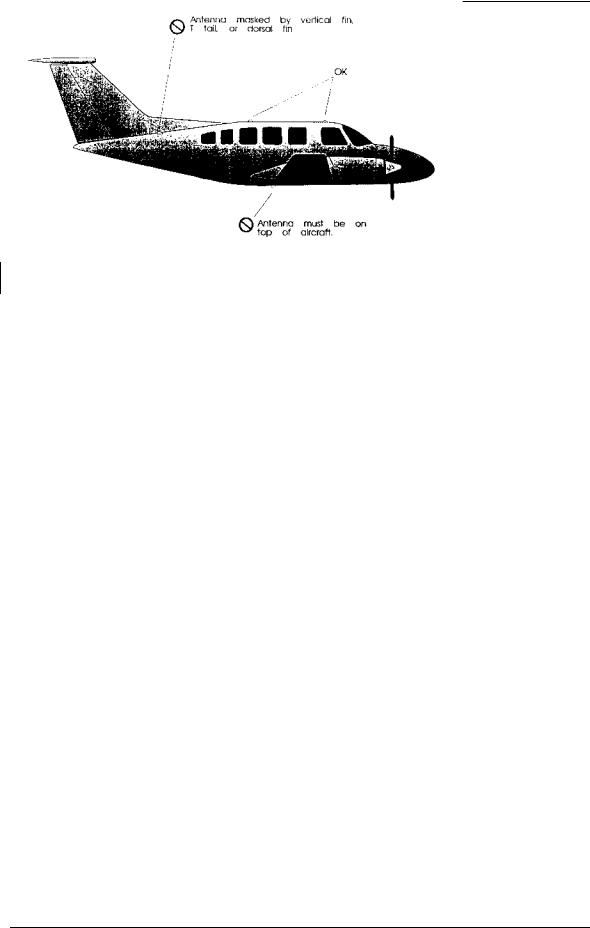
2.2.6ANTENNA LIMITATIONS
Garmin’s GA 56 Antennas are recommended for installations where the airspeed of the aircraft is subsonic. In such installations, GA 56—Mod 1 or later—must be used. See the COM, VOR/LOC, and Glideslope antenna specifications for their limitations.
2.2.7VHF COM INTERFERENCE OF GPS
On many panel-mounted installations, VHF COM transceivers can radiate strong harmonics from the transceiver and its antenna. The 400 Series COM does not interfere with its own GPS section. However, placement of the GA 56 GPS antenna relative to a COM transceiver and COM antenna, including the GNC 420 or GNS 430 COM antenna, is critical.
Use the following guidelines, in addition to others in this document, when locating the 400 Series unit and its antennas.
•GPS Antenna—Locate as far as possible from all COM antennas and all COM transceivers (including the 400 Series COM). The GPS antenna is less susceptible to harmonic interference if a 1.57542 GHz notch filter is installed on the COM transceiver antenna output.
•Locate the 400 Series unit as far as possible from all COM antennas.
Figure 2-1. GPS Antenna and Unit Installation Considerations
If a COM antenna is found to be the problem, a 1.57542 GHz notch filter (Garmin P/N 330-00067-00) may be installed in the VHF COM coax, as close to the COM as possible. This filter is not required for the GNC 420 and GNS 430 transmitters.
If a COM is found to be radiating, the following can be done:
1.Replace or clean the VHF COM rack connector to ensure good coax ground.
2.Place grounding straps between the 400 Series unit, VHF COM and a good ground.
3.Shield the VHF COM wiring harness.
Page 2-2 |
400 SERIES INSTALLATION MANUAL |
Page Rev L |
P/N 190-00140-02 |

2.2.8COM, VOR/LOC, and Glideslope Antenna Installation Instructions
Install the COM, VOR/LOC, and Glideslope antennas according to the manufacturer’s recommendations. Avoid running other wires and coaxial cables near the VOR/LOC antenna cable.
2.3RACK CONSIDERATIONS
Plan a location which gives the pilot complete and comfortable access to the entire keypad and which is plainly visible from the pilot’s perspective. Installation of remote switches and annunciators may not be required if the 400 Series unit is installed in the pilot’s normal field of view (refer to the FAA letter in Appendix B).
Check that there is adequate depth for the rack in the instrument panel. A location away from heating vents or other sources of heat generation is optimal.
2.4CABLING AND WIRING
Coaxial cable with 50 Ω nominal impedance and meeting applicable aviation regulations should be used for the installation. A typical maximum cable length for the GPS antenna is 40 feet. The installer should insure that the attenuation does not exceed 10 dB at 1.5 GHz for the specific installation.
Check that there is ample space for the cabling and mating connectors. Avoid sharp bends in cabling, particularly the COM antenna cable, and routing near aircraft control cables. Cabling for the 400 Series unit should not be routed near components or cabling which are sources of electrical noise. Do not route the COM antenna coax near any ADF antenna cables. Route the GPS, VOR/LOC, and Glideslope antenna cables as far as possible away from all COM transceivers and antenna cables.
2.5COOLING AIR
The 400 Series units meet all TSO requirements without external cooling. However, as with all electronic equipment, lower operating temperatures extend equipment life. On the average, reducing the operating temperature by 15-20 °C (25 to 35 °F) doubles the mean time between failure (MTBF). Recommended airflow rating is 1 CFM (cubic foot per minute) at a pressure equivalent to 0.1 inches of water. Potential damage to your 400 Series unit may occur by using outside forced air to cool the equipment. Therefore, it is recommended that an electric forced air fan be installed, of the indicated rating, to cool this equipment.
Units tightly packed in the avionics stack heat each other through radiation, convection, and sometimes by direct conduction. Even a single unit operates at a much higher temperature in still air than in moving air. Fans or some other means of moving the air around electronic equipment are usually a worthwhile investment. A 5/8” diameter air fitting is provided on the rear of the mounting rack for the purpose of admitting cooling air under such conditions. If a form of forced air cooling is installed, make certain that rainwater cannot enter and be sprayed on the equipment.
2.6MINIMUM INSTALLATION REQUIREMENTS
Below is a list of required devices for TSO C129a category A1 and A2 certification. For a specific list of equipment used in the initial STC, obtain a copy of “GNS 430 in Piper PA32 Documented Installation” (P/N 190-00140-06). The FAA or the governing organization should approve deviations from that set of equipment.
Pressure Altitude Device
This device delivers pressure altitude data to the 400 Series unit. This data can come from a parallel encoding altimeter, blind encoder, serializer, or an air data system.
Manual Course Device (Required for GNS 430 Only)
This device delivers the manual course select to the 400 Series unit, which is required for the GNS 430 VOR receiver, and optional for the 400/420/430 GPS receiver. Course information can come from an analog resolver, or from an EFIS/EHSI via ARINC 429 serial data.
HSI/CDI Indicator or EFIS
This device displays Nav Flag, Left/Right, To/From, Glideslope Flag, and Up/Down. The indicator(s) used in conjunction with the GNS 430 VOR/ILS receivers shall be TSO'd.
400 SERIES INSTALLATION MANUAL |
Page 2-3 |
P/N 190-00140-02 |
Page Rev L |

Qualified GPS Antenna
This antenna must be one of those listed in the accessories list, or meet the following requirements:
1.DO-160C Environmental Conditions
The antenna shall meet the environmental conditions listed below and shall conform to the test requirements of RTCA DO-160C.
Environmental Condition |
Category |
Description |
|
||
Temperature |
(operating) |
F2 |
|
-55 to +70oC |
|
|
(ground survival) |
F2 |
|
-55 to +85oC |
|
Altitude |
|
F2 |
|
55,000 feet |
|
Temperature Variation |
A |
|
10oC per minute |
||
Humidity |
|
C |
|
95% at +55oC |
|
Vibration |
|
CLMY |
|
Turbo/Reciprocating/Helicopter |
|
Waterproofness |
|
S |
|
Continuous Stream |
|
Fluids |
|
F |
|
Deicing Fluid |
|
Lightning |
|
2A |
|
Direct Effects |
|
Icing |
|
C |
|
0.15” thick |
|
2. Electrical Characteristics |
|
|
|
|
|
LNA Supply voltage |
|
4.5 ± 0.5 VDC |
|||
LNA Supply Current |
|
20 mA Maximum |
|||
LNA Operating Frequency |
|
|
1575.42 ± 2.00 MHz |
||
LNA Gain |
|
|
20 dB Maximum, 12dB Minimum |
||
LNA Noise Figure |
|
3.0 dB Maximum |
|||
LNA Output VSWR (50 Ω) |
|
2:1 Maximum |
|||
LNA Input power at -1 dB Gain Compression |
-6 dB Minimum |
||||
LNA Bandwidth |
|
|
|
|
|
(-3 dB) |
|
|
40 MHz Maximum |
||
(-20 dB) |
|
|
100 MHz Maximum |
||
(-40 dB) |
|
|
250 MHz Maximum |
||
3.Radiation Characteristics
Polarization |
RHCP |
Operating Frequency |
1575.42 ± 2.00 MHz |
Gain (on axis) |
2.0 dBic Minimum |
(at 160o beam width) |
-6.0 dBic Minimum |
Cross Pole Gain (LHCP) |
|
(on axis) |
-8 dBic Maximum |
(at 160o beam width) |
-9 dBic Maximum |
4.Mounting Requirements
Cable connection |
BNC Female |
Mounting studs |
Four 8-32 UNC-2A studs 0.50” long |
Page 2-4 |
400 SERIES INSTALLATION MANUAL |
Page Rev L |
P/N 190-00140-02 |

3.INSTALLATION PROCEDURE
3.1UNIT AND ACCESSORIES
The 400 Series units are available under the following part numbers:
3.1.1GNS 430 (A)
CATALOG |
UNIT |
GNS |
ACCESSORIES |
COLOR |
OPERATING |
MINIMUM |
P/N |
P/N |
430A |
(1) |
|
VOLTAGE |
XMIT PWR |
010-00139-00 |
011-00280-00 |
N |
N |
BLACK |
28 |
10 W |
010-00139-01 |
011-00280-00 |
N |
Y |
BLACK |
28 |
10 W |
010-00139-10 |
011-00280-10 |
N |
N |
BLACK |
14 or 28 Vdc |
10 W |
010-00139-11 |
011-00280-10 |
N |
Y |
BLACK |
14 or 28 Vdc |
10 W |
010-00139-30 |
011-00280-30 |
N |
N |
GRAY |
14 or 28 V (2) |
10 W |
010-00139-31 |
011-00280-30 |
N |
Y |
GRAY |
14 or 28 V (2) |
10 W |
010-00286-00 |
011-00836-00 |
Y |
N |
BLACK |
28 Vdc |
16 W |
010-00286-01 |
011-00836-00 |
Y |
Y |
BLACK |
28 Vdc |
16 W |
010-00286-10 |
011-00836-10 |
Y |
N |
GRAY |
28 Vdc (2) |
16 W |
010-00286-11 |
011-00836-10 |
Y |
Y |
GRAY |
28 Vdc (2) |
16 W |
1) The following accessories are included with the GNS 430 (A) for those indicated with a “Y” above:
MOUNTING RACK (115-00243-00)
CONNECTOR KIT (011-00351-00)
BACK PLATE ASSEMBLY (011-00676-00)
GNS 430 PRODUCT INFO KIT (K00-00055-00)
2) Denotes alternate (secondary) power input available, (review installation drawing).
400 SERIES INSTALLATION MANUAL |
Page 3-1 |
P/N 190-00140-02 |
Page Rev L |

3.1.2GNC 420 (A)
CATALOG |
UNIT |
GNC |
ACCESSORIES |
COLOR |
OPERATING |
MINIMUM |
P/N |
P/N |
420A |
(1) |
|
VOLTAGE |
XMIT PWR |
010-00173-00 |
011-00506-00 |
N |
N |
BLACK |
28 |
10 W |
010-00173-01 |
011-00506-00 |
N |
Y |
BLACK |
28 |
10 W |
010-00173-10 |
011-00506-10 |
N |
N |
BLACK |
14 or 28 Vdc |
10 W |
010-00173-11 |
011-00506-10 |
N |
Y |
BLACK |
14 or 28 Vdc |
10 W |
010-00173-30 |
011-00506-30 |
N |
N |
GRAY |
14 or 28 V (2) |
10 W |
010-00173-31 |
011-00506-30 |
N |
Y |
GRAY |
14 or 28 V (2) |
10 W |
010-00287-00 |
011-00837-00 |
Y |
N |
BLACK |
28 Vdc |
16 W |
010-00287-01 |
011-00837-00 |
Y |
Y |
BLACK |
28 Vdc |
16 W |
010-00287-10 |
011-00837-10 |
Y |
N |
GRAY |
28 Vdc (2) |
16 W |
010-00287-11 |
011-00837-10 |
Y |
Y |
GRAY |
28 Vdc (2) |
16 W |
1) The following accessories are included with the GNS 420 (A) for those indicated with a “Y” above:
MOUNTING RACK (115-00243-00)
CONNECTOR KIT (011-00351-01)
BACK PLATE ASSEMBLY (011-00676-01)
GNC 420 PRODUCT INFO KIT (K00-00057-00)
2) Denotes alternate (secondary) power input available, (review installation drawing).
3.1.3GPS 400
CATALOG |
UNIT |
ACCESSORIES |
COLOR |
ALT PWR |
P/N |
P/N |
(1) |
|
AVAILABL |
|
|
|
|
E |
010-00171-00 |
011-00504-00 |
N |
BLACK |
N |
010-00171-01 |
011-00504-00 |
Y |
BLACK |
N |
010-00171-10 |
011-00504-10 |
N |
GRAY |
Y |
010-00171-11 |
011-00504-10 |
Y |
GRAY |
Y |
1) The following accessories are included with the GPS 400 for those indicated with a “Y” above:
MOUNTING RACK (115-00243-00)
CONNECTOR KIT (011-00351-03)
BACK PLATE ASSEMBLY (011-00676-03)
GPS 400 PRODUCT INFO KIT (K00-00056-00)
Alternate (secondary) power input available (review installation drawing).
Page 3-2 |
400 SERIES INSTALLATION MANUAL |
Page Rev L |
P/N 190-00140-02 |

The following installation accessories are available:
1.GPS Antenna Options:
•GA 56 Antenna Kit, without cable (Mod 1 or later, Garmin P/N 010-10040-01). This kit contains the following items:
ITEM |
GARMIN P/N |
QTY |
GA 56 ANTENNA SUB-ASSEMBLY |
011-00134-00 |
1 |
BACKING PLATE |
115-00031-00 |
1 |
NUT, SELF-LOCKING, #8-32 |
210-10004-09 |
4 |
ANTENNA GASKET |
253-00002-00 |
1 |
•GA 56 Flange Mount Antenna Kit (Mod 1 or later, Garmin P/N 010-10040-02). This kit contains the following items:
ITEM |
GARMIN P/N |
QTY |
FLANGE MOUNT GA 56 ANTENNA |
011-00147-00 |
1 |
SUB-ASSEMBLY |
|
|
NUT PLATE |
115-00080-00 |
1 |
SCREW, #10-32 x 5/8” |
211-62212-14 |
4 |
ANTENNA GASKET |
253-00011-00 |
1 |
2. Other accessories include the following:
ITEM |
GARMIN P/N |
|
MOUNTING RACK, 400/420/430 |
115-00243-00 |
|
GPS 400 BACK PLATE ASSEMBLY |
011-00676-03 |
|
GPS 400 CONNECTOR KIT |
011-00351-03 |
|
GNC 420 BACK PLATE ASSEMBLY |
011-00676-01 |
|
GNC 420 CONNECTOR KIT |
011-00351-01 |
|
GNS 430 BACK PLATE ASSEMBLY |
011-00676-00 |
|
GNS 430 CONNECTOR KIT |
011-00351-00 |
|
400 SERIES ADDENDUM FOR TRAFFIC |
190-00140-10 |
|
& WEATHER INTERFACES |
|
|
GPS 400 PILOT’S GUIDE |
190-00140-60 |
|
GPS 400 QUICK REFERENCE GUIDE |
190-00140-61 |
|
GPS 400 SAMPLE AIRPLANE FLIGHT |
190-00140-64 |
|
MANUAL SUPPLEMENT |
|
|
GNC 420 PILOT’S GUIDE |
190-00140-20 |
|
GNC 420 QUICK REFERENCE GUIDE |
190-00140-21 |
|
GNC 420 SAMPLE AIRPLANE FLIGHT |
190-00140-24 |
|
MANUAL SUPPLEMENT |
|
|
GNS 430 PILOT’S GUIDE |
190-00140-00 |
|
GNS 430 QUICK REFERENCE GUIDE |
190-00140-01 |
|
GNS 430 SAMPLE AIRPLANE FLIGHT |
190-00140-04 |
|
MANUAL SUPPLEMENT |
|
|
|
|
|
|
NOTE |
|
A mounting rack is required for approved installations. The following hardware is required for installation of the mounting rack, but is not provided--#6-32 Flat Head Screw (6 ea.), #6-32 Self-locking Nut (6 ea.).
400 SERIES INSTALLATION MANUAL |
Page 3-3 |
P/N 190-00140-02 |
Page Rev L |

3.2 DATA BASE OPTIONS |
|
ITEM |
GARMIN P/N |
DATA CARD, WORLD WIDE |
010-10201-00 |
DATA CARD, AMERICAS |
010-10201-01 |
DATA CARD, INTERNATIONAL |
010-10201-02 |
3.3 MISCELLANEOUS OPTIONS
ITEM |
GARMIN P/N |
CONNECTOR, BNC, MALE, CLAMP |
330-00087-00 |
LOW-LOSS AVIATION ANTENNA |
320-00003-00 |
EXTENSION CABLE WITH RIGHT |
|
ANGLE BNC CONNECTOR, 15 FT. |
|
LOW-LOSS AVIATION ANTENNA |
320-00003-02 |
EXTENSION CABLE WITH RIGHT |
|
ANGLE BNC CONNECTOR, 30 FT. |
|
GPS 1.57542 GHz NOTCH FILTER |
330-00067-00 |
3.4INSTALLATION ACCESSORIES REQUIRED BUT NOT PROVIDED
The following installation accessories are required but not provided:
COM Antenna: |
(GNC 420 and GNS 430 |
Only) Shall meet TSO C37() and C38(). Broad band, 50 |
|
Ω, vertically polarized with coaxial cable |
|
VOR/LOC Antenna: |
(GNS 430 Only) Shall meet TSO C40() and C36(). Broad band, 50 Ω, |
|
|
horizontally polarized with coaxial cable |
|
Glideslope Antenna: |
(GNS 430 Only) Shall meet TSO C34(). Broad band, 50 Ω, horizontally polarized |
|
|
with coaxial cable or low-loss splitter used with the VOR/LOC antenna |
|
Headphones: |
(GNC 420 and GNS 430 |
Only) 500 Ω nominal impedance |
Microphone: |
(GNC 420 and GNS 430 |
Only) Low impedance, carbon or dynamic, with |
|
transistorized pre-amp |
|
3.5ANTENNA INSTALLATION
For the COM, VOR/LOC, and Glideslope antennas, follow the manufacturers’ instructions.
The remainder of this section applies to the GPS antenna. The GA 56 antenna outline and footprint dimensions are shown in Figure 3-2, page 3-9. Also refer to 190-00094-00 GA 56 Antenna Installation Instructions.
1.Using the backing plate as a template, mark the location of the mounting holes and the through hole for coaxial cable. Drill or punch the holes.
2.The antenna installation must provide adequate support for the antenna, considering a maximum drag load of 5 lbs. for the GA 56 antennas (at subsonic speed). Install a doubler plate to reinforce thin-skinned aircraft. Observe guidelines for acceptable installation practices as outlined in AC 43.13-2A.
Seal the antenna and gasket to the fuselage using a good quality electrical grade sealant. Use caution to insure that the antenna connector is not contaminated with sealant. Insure that the mounting screws are fully tightened and that the antenna base is well seated against the gasket.
CAUTION
Do not use construction grade RTV sealant or sealants containing acetic acid. These sealants may damage the electrical connections to the antenna. Use of these type sealants may void the antenna warranty.
Page 3-4 |
400 SERIES INSTALLATION MANUAL |
Page Rev L |
P/N 190-00140-02 |
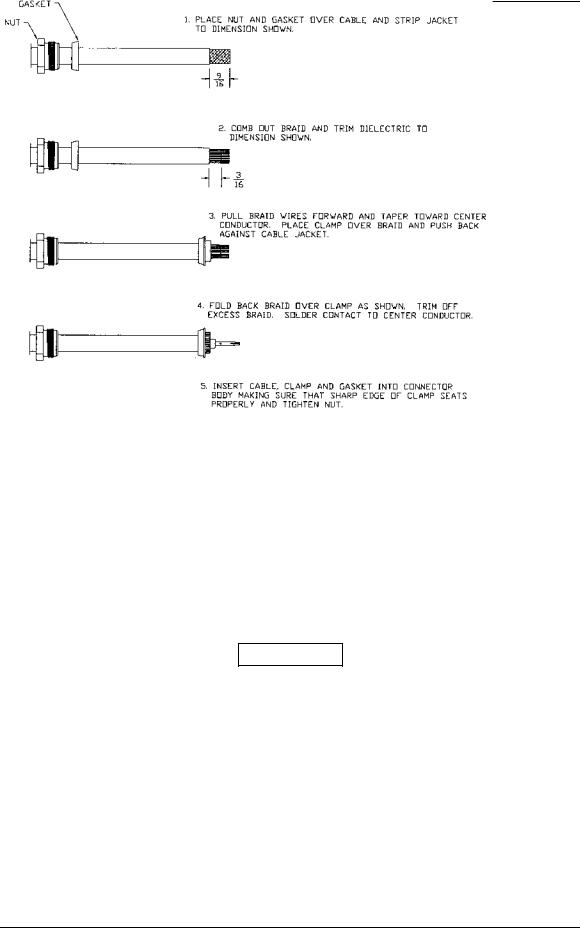
3.6CABLE INSTALLATION
1.Route the coaxial cable to the rack location keeping in mind the recommendations of Section 2. Secure the cable in accordance with good aviation practice.
2.Trim the coaxial cable to the desired length and install the BNC connector (330-00087-00) per the cabling instructions on Figure 3-1. If the connector is provided by the installer, follow the connector manufacturer’s instructions for cable preparation.
Figure 3-1. Coaxial Cable Installation
3.The card-edge connector may be used to terminate shield grounds to the 400 Series back plate.
CAUTION
4.Feed wires through the connector backshells before insertion into the 78, 44, and 25 pin connectors.
5.Contacts for the 78, 44 and 25 pin connectors must be crimped onto the individual wires of the aircraft wiring harness. The following tables list contact part numbers (for reference) and recommended crimp tools:
Table 3-1. Pin Contact Part Numbers
|
78 pin conn |
44 pin conn |
25 pin connector (P4002) |
Shield ground |
|
|
(P4001) |
(P4006) |
|
|
connector |
Connector Type |
High Density Pin Contact |
Standard Density Socket Contact |
.1” Pitch Card-edge |
||
Wire Gauge |
22-28 AWG |
18 AWG |
20-24 AWG |
20-24 AWG |
|
Garmin P/N |
336-00021-00 |
336-00023-00 |
336-00022-00 |
336-00029-00 |
|
Military P/N |
M39029/58-360 |
N/A |
M39029/63-368 |
N/A |
|
AMP |
204370-2 |
N/A |
205090-1 |
583853-4 |
|
Positronic |
M39029/58-360 |
FC6018D |
M39029/63-368 |
N/A |
|
ITT Cannon |
030-2042-000 |
See Note 3 |
031-1007-042 |
N/A |
|
400 SERIES INSTALLATION MANUAL |
Page 3-5 |
P/N 190-00140-02 |
Page Rev L |

Table 3-2. Recommended Crimp Tools (or equivalent)
Connector |
|
High Density |
|
Standard Density |
|
||
Type |
|
|
|
|
|
|
|
Wire Gauge |
|
22-28 AWG |
18 AWG |
20-24 AWG |
|||
|
Hand |
Positioner |
Insertion/ |
Positioner |
Insertion/ |
Positioner |
Insertion/ |
|
Crimping |
|
Extraction |
|
Extraction |
|
Extraction |
|
Tool |
|
Tool |
|
Tool |
|
Tool |
Military P/N |
M22520/2-01 |
M22520/2-09 |
M81969/1-04 |
N/A |
M81969/1-02 |
M22520/2-08 |
M81969/1-02 |
Positronic |
9507 |
9502-3 |
M81969/1-04 |
9502-11 |
M81969/1-02 |
9502-5 |
M81969/1-02 |
ITT Cannon |
995-0001- |
995-0001- |
N/A |
N/A |
N/A |
995-0001- |
980-2000- |
|
584 |
739 |
|
|
|
604 |
426 |
AMP |
601966-1 |
601966-6 |
91067-1 |
N/A |
N/A |
601966-5 |
91067-2 |
Daniels |
AFM8 |
K42 |
M81969/1-04 |
K774 |
M81969/1-02 |
K13-1 |
M81969/1-02 |
Astro |
615717 |
615725 |
M81969/1-04 |
N/A |
M81969/1-02 |
615724 |
M81969/1-02 |
NOTES
1.Insertion/extraction tools from ITT Cannon are all plastic; others are plastic with metal tip.
2.Non-Garmin part numbers shown are not maintained by Garmin and consequently are subject to change without notice.
3.Alternate contacts for 18 AWG wire: As an alternative to the Positronic contacts listed (and provided in the installation kit), the installer may use contacts made by ITT Cannon under P/N 031-1007-001. These contacts require the use of a different crimp tool positioner than shown in the table, with the part numbers as follows: Daniels P/N K250, Astro P/N 616245, or ITT Cannon P/N 980-0005-722.
4.For the card-edge connector pin contacts, use AMP part number 90272-1 or equivalent crimping tool.
3.7RACK INSTALLATION
1.The back plate of the rack may optionally be removed for ease of mounting in the aircraft panel. To do so, remove the two #4-40 screws, tilt the back plate away from the tray, and then slide the back plate to the side.
2.Figures 3-3, 3-4 and 3-5, starting on pages 3-11, 3-13, and 3-15, show outline dimensions for the aviation rack for the various 400 Series units. Install the rack in a rectangular 6.320” x 2.700” hole (or gap between units) in the instrument panel (refer to Figure 3-9, page 3-23). The lower-front lip of the rack should be flush with, or extend slightly beyond, the finished aircraft panel.
CAUTION
If the front lip of the mounting rack is behind the surface of the aircraft panel, the 400 Series unit connectors may not fully engage.
Make sure that no screw heads or other obstructions prevent the unit from fully engaging in the rack (refer to the “Connector Engagement Test,” section 5.3.1, page 5-15). Exercise caution when installing the rack into the instrument panel. The rack is designed to facilitate removal of the 400 Series for use in Demo Mode outside the aircraft. Deformation of the rack may make it difficult to install and remove the 400 Series unit.
3.Install the rack in the aircraft panel using six #6-32 flat head screws and six self-locking nuts. The screws are inserted from the inside through the holes in the sides of the rack.
4.If the back plate was previously removed (see step #1), replace the back plate by positioning the tabs on the back plate in the slots of the left side of the rack (viewing it from the cockpit) and attaching it by replacing the two #4-40 screws.
Page 3-6 |
400 SERIES INSTALLATION MANUAL |
Page Rev L |
P/N 190-00140-02 |

3.8400 SERIES UNIT INSERTION AND REMOVAL
The 400 Series unit is installed in the rack by sliding it straight in until it stops, about 1 inch short of the final position. A 3/32“ hex drive tool is then inserted into the access hole at the bottom of the unit face. Rotate the hex tool clockwise while pressing on the left side of the bezel until the unit is firmly seated in the rack. It may be necessary to insert the hex drive tool into the access hole and rotate the mechanism 90° counterclockwise to insure correct position prior to placing the unit in the rack.
To remove the unit from the rack, insert the hex drive tool into the access hole on the unit face and rotate counterclockwise until the unit is forced out about 3/8 ” and can be freely pulled from the rack.
Be sure not to over tighten the unit into the rack. The application of hex drive tool torque exceeding 15 in•lbs can damage the locking mechanism.
3.9COM ANTENNA INSTALLATION CHECK (GNC 420 AND GNS 430)
Check for insertion loss and VSWR (voltage standing wave ratio). VSWR should be checked with an inline type VSWR/wattmeter inserted in the coaxial transmission line between the transceiver and the antenna. The VSWR should be inserted as close to the transceiver as possible. When rack and harness buildup is performed in the shop, the coax termination may be provisioned by using a 6” inline BNC connection. This would be an acceptable place to insert the VSWR. Any problem with the antenna installation is most likely seen as high reflected power. A VSWR of 3:1 may result in up to a 50% loss in transmit power.
400 SERIES INSTALLATION MANUAL |
Page 3-7 |
P/N 190-00140-02 |
Page Rev L |

This page intentionally left blank.
Page 3-8 |
400 SERIES INSTALLATION MANUAL |
Page Rev L |
P/N 190-00140-02 |
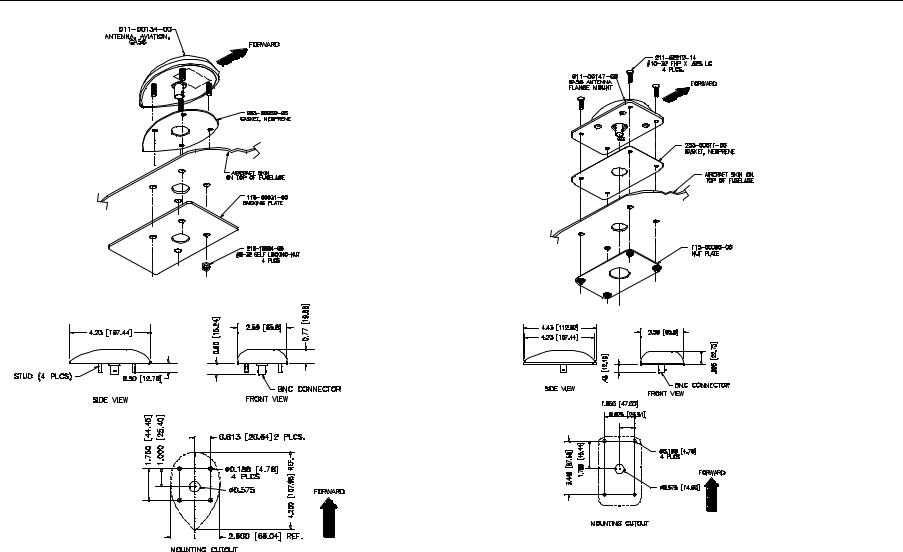
3.10GA 56 Antenna Installation Drawing
Figure 3-2. GA 56 Antenna Installation Drawing
400 SERIES INSTALLATION MANUAL |
Page 3-9 (Page 3-10 blank) |
P/N 190-00140-02 |
Page Rev L |
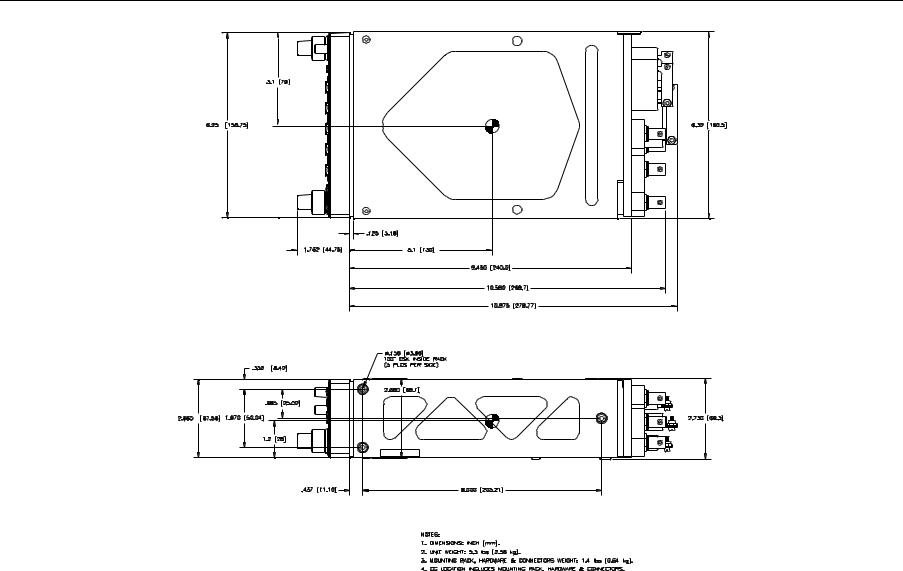
3.11Mounting Rack Dimensions
Figure 3-3. GNS 430 Mounting Rack Dimensions
400 SERIES INSTALLATION MANUAL |
Page 3-11 (Page 3-12 blank) |
P/N 190-00140-02 |
Page Rev L |
